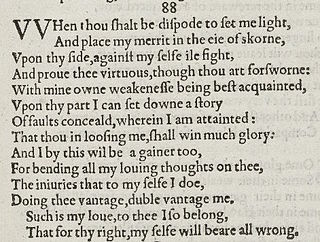
Sonnet 1 is one of 154 sonnets written by the English playwright and poet William Shakespeare. It is a procreation sonnet within the Fair Youth sequence.

Sonnet 18 is one of the best-known of the 154 sonnets written by English poet and playwright William Shakespeare.

Sonnet 153 is a sonnet by William Shakespeare.

Sonnet 27 is one of 154 sonnets published by William Shakespeare in a quarto titled Shakespeare's Sonnets in 1609. It is a part of the Fair Youth group of sonnets, and the first in a group of five sonnets that portray the poet in solitude and meditating from a distance on the young man. A theme of the first two of the group regards the night and restlessness, which is a motif also found in the sonnets of Petrarch.

Sonnet 28 is one of 154 sonnets published by the English playwright and poet William Shakespeare in 1609. It is a part of what is considered the Fair Youth group, and part of another group that focuses on the solitary poet reflecting on his friend. There is a theme of night and sleeplessness, which is a traditional motif that also occurs in Petrarchan sonnets.

Sonnet 39 is one of 154 sonnets written by the English playwright and poet William Shakespeare. It is a member of the Fair Youth sequence, in which the poet expresses his love towards a young man.

Sonnet 63 is one of 154 sonnets published in 1609 by the English playwright and poet William Shakespeare. It is one of the Fair Youth sequence. Contrary to most of the other poems in the Fair Youth sequence, in Sonnets 63 to 68 there is no explicit addressee, and the second person pronoun is not used anywhere in sonnets 63 to 68.

Sonnet 98 is one of 154 sonnets written by the English playwright and poet William Shakespeare. It is a member of the Fair Youth sequence, in which the persona expresses his love towards a young man. It is the second of a group of three sonnets to treat a separation of the speaker from his beloved.

Sonnet 76 is one of 154 sonnets published by the English playwright and poet William Shakespeare in 1609. It's a member of the Fair Youth sequence.
Shakespeare's 77th sonnet is the half-way point of the book of 154 sonnets. The poet here presents the idea of the young man taking on the role of poet and writing about himself. This sonnet makes use of the rhetorical device termed correlatio, which involves a listing and correlating of significant objects, and which was perhaps overused in English sonnets. The objects here are a mirror, a time piece and a notebook, each representing a way towards self-improvement for the young man as poet.

Sonnet 79 is one of 154 sonnets published by the English playwright and poet William Shakespeare in 1609. It is part of the Fair Youth sequence, and the second sonnet of the Rival Poet sequence.

Sonnet 80 is one of 154 sonnets published by the English playwright and poet William Shakespeare in 1609. It is part of the Fair Youth sequence, and the third sonnet of the Rival Poet sequence.

Sonnet 88 is one of 154 sonnets published in 1609 by the English playwright and poet William Shakespeare. It's one of the Fair Youth sequence.

Sonnet 81 is one of 154 sonnets written by William Shakespeare, and published in a quarto titled Shakespeare's Sonnets in 1609. It is a part of the Fair Youth series of sonnets, and the fourth sonnet of the Rival Poet series.

Sonnet 82 is one of 154 sonnets published by William Shakespeare in a quarto titled Shakespeare's Sonnets in 1609. It is a part of the Fair Youth series of sonnets, and the fifth sonnet of the Rival Poet group.

Sonnet 83 is one of 154 sonnets published by William Shakespeare in a quarto titled Shakespeare's Sonnets in 1609. It is a part of the Fair Youth group of sonnets, and the sixth sonnet of the Rival Poet group.

Sonnet 84 is one of 154 sonnets published by the English playwright and poet William Shakespeare in 1609. It's part of the Fair Youth sequence, and the seventh sonnet of the Rival Poet group.

Sonnet 85 is one of 154 sonnets published by the English playwright and poet William Shakespeare in 1609. It's part of the Fair Youth sequence, and the eighth sonnet of the Rival Poet group.

Sonnet 86 is one of 154 sonnets first published by the English playwright and poet William Shakespeare in the Quarto of 1609. It is the final poem of the Rival Poet group of the Fair Youth sonnets in which Shakespeare writes about an unnamed young man and a rival poet competing for the youth's favor. Though the exact date of its composition is unknown, it has been suggested that the Rival Poet series may have been written between 1598 and 1600.

Sonnet 96 is one of 154 sonnets written by the English playwright and poet William Shakespeare. It is a member of the Fair Youth sequence.





















